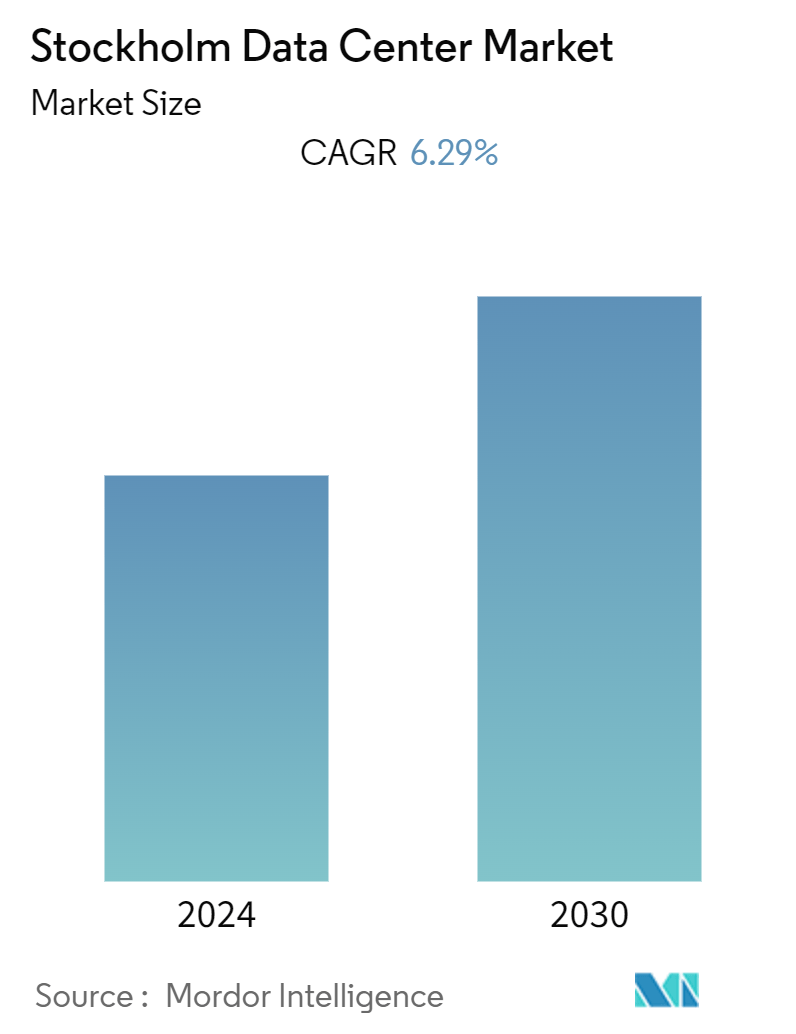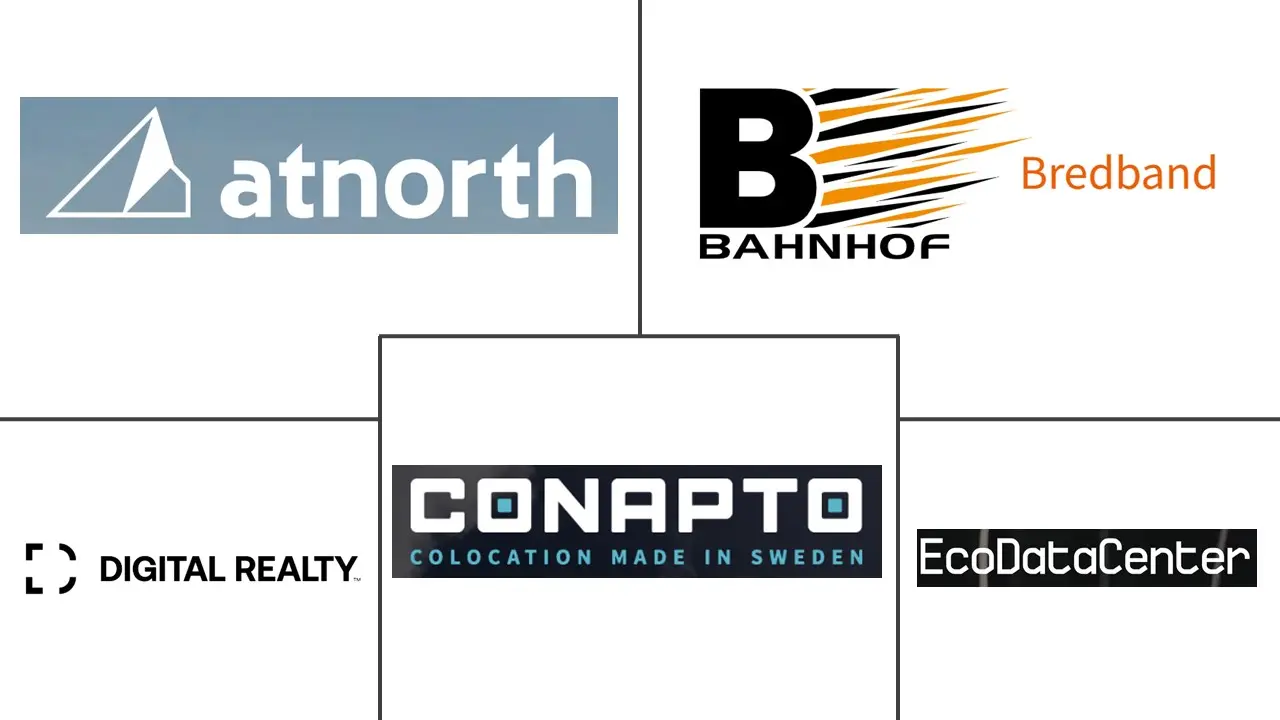Market Size of Stockholm Data Center Industry

| Study Period | 2018 - 2030 |
| Base Year For Estimation | 2023 |
| Forecast Data Period | 2024 - 2030 |
| Historical Data Period | 2018 - 2022 |
| CAGR (2024 - 2030) | 6.29 % |
| Market Concentration | Medium |
Major Players
*Disclaimer: Major Players sorted in no particular order |
Need a report that reflects how COVID-19 has impacted this market and its growth?
Stockholm Data Center Market Analysis
The Stockholm Data Center Market is expected to register a CAGR of 6.29% during the forecast period.
The main drivers anticipated to drive market expansion are the increasing demand for energy-efficient data centers, considerable investment by colocation and managed service providers, and expanding hyperscale data center buildings. Additionally, the development of big data, cloud computing, and the Internet of Things (IoT) has made it possible for businesses to invest in new data centers to preserve business continuity.
- Additionally, industrial development is expected to prosper due to the rising need for security, operational efficiency, improved mobility, and bandwidth. Software-based data centers boost industry growth by providing a higher level of automation.
- As individuals spend more time online, telcos require more servers and low-latency connectivity choices. The scale and interconnectedness of hyperscale data centers will be needed to satisfy growing demand. In 2023, services will be dispersed, deployed, and operated over various resources, such as private or public cloud services, networks, and devices, all of which will continue to work in unison to deliver a single service or package of services. Private clouds give greater control and security, whereas public clouds offer enormous processing capacity. Trends like these are expected to drive the studied market.
- For instance, recently, Microsoft Corporation opened its newest sustainable data center region in Sweden, with locations in Gävle, Sandviken, and Staffanstorp. Microsoft's new world-class data centers in Sweden are now operational. Microsoft Azure and Microsoft 365 services are available immediately, providing advanced data protection, privacy, and the opportunity to store data in the country. The new data center region incorporates the best of Microsoft's sustainability investments, powering the data center with 100% carbon-free energy and supporting zero-waste operations, highlighting Microsoft's ongoing investment to help create new long-term opportunities in Sweden's commercial and public sectors.
- Further, in October 2022, the SciLifeLab Research Data Management (RDM) Guidelines web portal will be released. The portal, which SciLifeLab Data Center and NBIS created and maintained, will be a knowledge hub for managing life science research data in Sweden. It will include guidance on best practices for each phase of the research data life cycle, adherence to the FAIR principles, how to make user data as open as feasible, and how to maximize the research effect of data. The information will be specifically designed to relate to life science data from a Swedish research standpoint.
- On the flip side, development centers have conducted extensive research on energy efficiency in data centers, focusing on optimal QoS, efficient utilization of resources, and operation cost reduction. They aim to minimize brown energy utilization by proposing a load-balancing approach utilizing the available green energy. Load balancing is based on available renewable energy and has been installed in multiple data centers. A workload and energy management scheme was introduced to decrease the operational cost of the network and energy costs. Combined cooling, heating, and power (CCHP) systems can reduce carbon emissions and air pollution and increase resource efficiency.
Stockholm Data Center Industry Segmentation
A data center is a physical room, building, or facility that holds IT infrastructure used to construct, run, and provide applications and services and store and manage the data connected with those applications and services.
The Stockholm data center market is segmented by DC size (small, medium, large, massive, mega), by tier type (tier 1 and 2, Tier 3, Tier 4), by absorption (utilized, colocation type (retail, wholescale, hyperscale), end user (cloud & IT, telecom, media & entertainment, government, BFSI, manufacturing, e-commerce)), and non-utilized). The market sizes and forecasts are provided in terms of value (MW) for all the above segments.
| DC Size | |
| Small | |
| Medium | |
| Large | |
| Massive | |
| Mega |
| Tier Type | |
| Tier 1 & 2 | |
| Tier 3 | |
| Tier 4 |
| Absorption | |||||||||||||||||
| |||||||||||||||||
| Non-Utilized |
Stockholm Data Center Market Size Summary
The Stockholm data center market is poised for significant growth, driven by the increasing demand for energy-efficient solutions and substantial investments from colocation and managed service providers. The expansion of hyperscale data centers, alongside advancements in big data, cloud computing, and the Internet of Things, has created a fertile ground for new data center investments. These developments are further fueled by the rising need for enhanced security, operational efficiency, and improved connectivity. The market is witnessing a shift towards software-based data centers, which offer higher automation levels, catering to the growing demand for low-latency connectivity as more individuals engage online. The interplay between private and public cloud services continues to shape the market, with private clouds providing greater control and security, while public clouds offer vast processing capabilities.
The market landscape is semi-consolidated, with key players like AtNorth, Bahnhof, and Conapto actively expanding their presence through strategic partnerships and new developments. Recent initiatives include the establishment of new data centers and the introduction of innovative technologies, such as 100% green data centers. The retail colocation segment is experiencing robust growth, driven by the demand for cost-effective and flexible solutions, particularly among smaller enterprises. As the digital economy in Sweden continues to expand, the data center market is expected to evolve, with a focus on sustainability and efficiency. The introduction of tier-IV data centers, although limited, highlights the market's potential for high-reliability infrastructure, catering to sectors like government, finance, and media.
Stockholm Data Center Market Size - Table of Contents
-
1. MARKET SEGMENTATION
-
1.1 DC Size
-
1.1.1 Small
-
1.1.2 Medium
-
1.1.3 Large
-
1.1.4 Massive
-
1.1.5 Mega
-
-
1.2 Tier Type
-
1.2.1 Tier 1 & 2
-
1.2.2 Tier 3
-
1.2.3 Tier 4
-
-
1.3 Absorption
-
1.3.1 Utilized
-
1.3.1.1 Colocation Type
-
1.3.1.1.1 Retail
-
1.3.1.1.2 Wholesale
-
1.3.1.1.3 Hyperscale
-
-
1.3.1.2 End User
-
1.3.1.2.1 Cloud & IT
-
1.3.1.2.2 Telecom
-
1.3.1.2.3 Media & Entertainment
-
1.3.1.2.4 Government
-
1.3.1.2.5 BFSI
-
1.3.1.2.6 Manufacturing
-
1.3.1.2.7 E-Commerce
-
1.3.1.2.8 Other End-User
-
-
-
1.3.2 Non-Utilized
-
-
Stockholm Data Center Market Size FAQs
What is the current Stockholm Data Center Market size?
The Stockholm Data Center Market is projected to register a CAGR of 6.29% during the forecast period (2024-2030)
Who are the key players in Stockholm Data Center Market?
atNorth, Bahnhof AB, Conapto (Designrepublic.se), Interxion(Digital Realty Trust, Inc.) and EcoDataCenter are the major companies operating in the Stockholm Data Center Market.

